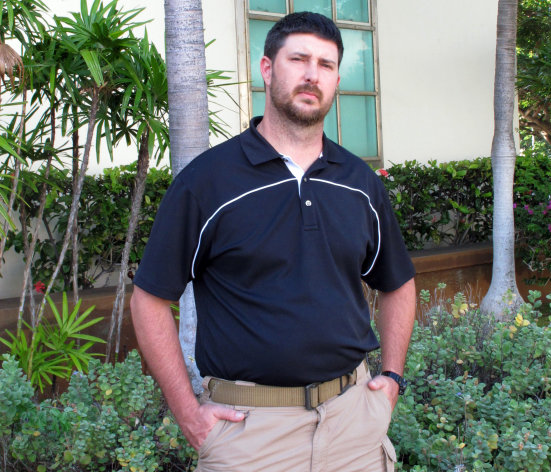Associated Press/Audrey McAvoy - In this Oct. 18, 2012, photo, Wade Hicks, Jr. poses for a photograph outside the pass office at Joint Base Pearl Harbor-Hickam, Hawaii. The 34-year-old from Gulfport, Miss. was stranded in Hawaii for five days after he found out he was on the no-fly list and wouldn't be allowed on an airplane until he was abruptly removed from the list with no explanation. (AP Photo/Audrey McAvoy)
JOINT BASE PEARL HARBOR-HICKAM, Hawaii (AP) — Hawaii is a paradise for most visitors. But it was Wade Hicks Jr.'s prison for five days.
The 34-year-old from Gulfport, Miss., was stranded in the islands this week after being told he was on the FBI's no-fly list during a layover for a military flight from California to Japan.
The episode left Hicks scrambling to figure out how he'd get home from Hawaii without being able to fly. Then he was abruptly removed from the list on Thursday with no explanation.
It also raised questions beyond how he landed on the list: How could someone on a list intelligence officials use to inform counterterrorism investigations successfully fly standby on an Air Force flight?
Hicks said he was traveling to visit his wife, a U.S. Navy lieutenant who's deployed in Japan. He hitched a ride on the military flight as is common for military dependents, who are allowed to fly on scheduled routes when there's room.
Hicks said that during his layover at Joint Base Pearl Harbor-Hickam, a U.S. Immigration and Customs Enforcement agent told him he was on the no-fly list and wouldn't be allowed on a plane.
"I said, 'How am I supposed to get off this island and go see my wife or go home?' And her explanation was: 'I don't know,'" Hicks said.
Hicks said he was shocked and thought they must have had the wrong person because he doesn't have a criminal record and recently passed an extensive background check in Mississippi to get a permit to carry a concealed weapon.
But the agent said his name, Social Security number and date of birth matched the person prohibited from flying, Hicks said. He wasn't told why and wondered whether his controversial views on the Sept. 11 terrorist attacks played a role. Hicks said he disagrees with the 9/11 Commission's conclusions about the attacks.
A Homeland Security spokesman referred questions to the FBI Terrorist Screening Center, which maintains the report. A spokesman for the center declined to comment on Hicks' case. The government doesn't disclose who's on the list or why someone might have been placed on it.
The list of roughly 20,000 people and about 500 to 600 Americans includes names and classified evidence against suspected terrorists who are not allowed to fly in U.S. airspace.
The list can be updated within minutes, so it's possible Hicks was added to the list while in midair from Travis Air Force Base in California to Hawaii.
A spokesman for Defense Secretary Leon Panetta's office said passengers who fly standby on military flights are screened against the FBI's list only on international flights. Domestic passengers are screened only through an internal military system, not the Advanced Passenger Information System run by Customs and Border Protection.
"It's scary to know that something like this can happen in a free country. You're not accused of any crime. You haven't been contacted by anyone. No investigation has been done. No due process has taken place," he said.
He got a hotel room at the Pearl Harbor naval base while he worked things out. Being on the list didn't stop him from staying on a base that's home to submarines, cruisers and destroyers.
Hicks said he called politicians in Mississippi and Hawaii and brainstormed ways to get home with friends, speculating on taking a private plane, a cruise ship or even a fishing boat from Alaska. He then got a call on Thursday that he had been removed from the no-fly list.
Hicks planned to take a military flight back to California on Friday to meet his wife, who will be coming from Japan, and said he plans to seek to recoup his added travel costs from the government.
___
Associated Press writer Eileen Sullivan in Washington contributed to this report.
Commentary: It's very shameful that this gentleman had to endure such disrespect from the federal government upon mysteriously ending up on the no fly list. This really makes you wonder whether the current white house administration is hiding anything else pertaining to this gentleman. I really hope this matter gets settled in a respectful manner pertaining to this gentleman.

